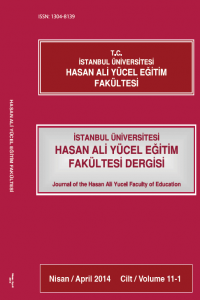Öz
Every new produced technology is a result of an accumulation and affects the community which it belongs to. It changes the ideas about the facts, the quality of icons and symbols and the nature of the field about which new ideas have been developed, in other words, the structure of the society. At the end of the 20th century and at present, in the early years of 21st century, the world history has witnessed innovations in the technological field at an unprecedented speed. In this process, the mass media has changed our ways of life styles, relationships, perceptions, and expressions reformatting us all over again.Media technologies have been used in theatre for a long time. In Adult’s Theatre some images, movies, photographs, documents which are especially about politics and support the theme help audiences to evaluate events in different perspectives. Technically, they also give opportunity to the director to organize the scene, for example to take the audiences to times or places impossible to go.* Doç.Dr., İÜ HAYEF, Fransızca Dili Eğitimi ABD, nihal.kuyumcu@yahoo.comWe encounter that Media Technologies have been also frequently used in Children’s Theatre recently. Within the scope of this study, children’s reactions toward the use of technology in Children’s Theatre. In this study the results of observations done on children during four children’s plays while they were watching plays show that children were not interested in the scene at all when there were no actors on the scene. There might be several reasons counted for this; the reasons for these findings may be uninteresting or unattractive images, or being under the bombardment of image and sound. Nevertheless, the fact that the children are interested in the scene when the actors are on is said to signify that they make their choice in favor of actors in such kind of a variety.The aim of this study is to determine the reactions of the children who are living in a mediatic world and under the bombardment of sound and vision during the plays by means of unstructed observation and make an evaluation of the results.
Anahtar Kelimeler
Communication technology Children’s Theatre alienation media. Communication technology children theater alienation.
Kaynakça
- Esslin, M., (1991),“Televizyon Öldüren Eğlence”,Pınar yayınları, 1991, İstanbul.
- Goldberg, M., (2008), ”Tiyatro ve Çocuk” Mitos-Boyut Yayınları, Tiyatro/kültür Dizisi 86,İstanbul.
- Modleski, T. (1998) “Eğlence İncelemeleri: Kitle kültürüne eleştirel Yaklaşımlar” Metis yayınları. İstanbul
- Paker, Ö. (2008), “Tiyatro Estetiği Oyun Metninde Estetik Denge” Papatya yayınları, Cilt I, İstanbul
- Plumb, J..H. (1971), “The great Change in Children” Horizon, Vol.13 No 1,Winter Postman, N, (1995), “Çocukluğun Yokoluşu” İmge yay. Ankara
- Tandaçgüneş, N., “Çocuğun Kültürel Yabancılaşmasında Televizyon: İlköğretimde dil Algılaması Üzerine Bir Olay” İ.Ü. İletişim Fakültesi, “1. Uluslararası Çocuk ve İletişim Konferansı, Bildiri kitabı
Öz
Kaynakça
- Esslin, M., (1991),“Televizyon Öldüren Eğlence”,Pınar yayınları, 1991, İstanbul.
- Goldberg, M., (2008), ”Tiyatro ve Çocuk” Mitos-Boyut Yayınları, Tiyatro/kültür Dizisi 86,İstanbul.
- Modleski, T. (1998) “Eğlence İncelemeleri: Kitle kültürüne eleştirel Yaklaşımlar” Metis yayınları. İstanbul
- Paker, Ö. (2008), “Tiyatro Estetiği Oyun Metninde Estetik Denge” Papatya yayınları, Cilt I, İstanbul
- Plumb, J..H. (1971), “The great Change in Children” Horizon, Vol.13 No 1,Winter Postman, N, (1995), “Çocukluğun Yokoluşu” İmge yay. Ankara
- Tandaçgüneş, N., “Çocuğun Kültürel Yabancılaşmasında Televizyon: İlköğretimde dil Algılaması Üzerine Bir Olay” İ.Ü. İletişim Fakültesi, “1. Uluslararası Çocuk ve İletişim Konferansı, Bildiri kitabı
Öz
Üretilen her yeni teknoloji ürünü bir birikim sonucu ortaya çıkar. İçinden çıktığı
toplumu, kültürünü etkiler. Hakkında düşünülen şeylerin yapısını değiştirir, simgelerin
niteliğini ve yeni düşüncelerin geliştirildiği alanın doğasını, bir başka deyişle toplumun
yapısını değiştirir. 20 yüzyılın sonu ve içinde yaşadığımız 21.yüzyılın başında
dünya tarihi, görülmemiş bir hızla teknoloji alanında yeniliklere tanık olmuştur. Bu
süreçte kitle iletişim araçları bizleri yeni baştan biçimlendirerek yaşam tarzlarımızı,
ilişkilerimizi, algılama ve ifade şekillerimizi değiştirmiştir.
Tiyatroda medya teknolojilerinin kullanımı öteden beri rastlanan bir durumdur.
Yetişkin tiyatrosunda özellikle politik belgesel tiyatroda kullanılan, anlatılan konuyu
destekleyen bir takım görüntüler, filmler, fotoğraflar, dokümanlar seyirciye olaya
çok yönlü bakmasında yardımcı olur. Teknik olarak da yönetmene, gidilemeyecek
mekânlara, zamanlara gitme, ortam oluşturma konusunda kolaylık sağlar.
Son yıllarda çocuk tiyatrosunda da medya teknolojilerinin kullanımı sıkça karşımıza
çıkmaktadır. Bu çalışma kapsamında çocuk tiyatrosunda teknoloji kullanımı karşısında
çocukların tepkileri incelenmiştir. Oyun sırasında, seyirci-çocuklar üzerinde yapılan
gözlemlerde, oyuncunun olmadığı, sadece görüntülerin yer aldığı sahnelerde çocukların
sahneyle ilgilenmediği görülmüştür. Bunun birçok nedeni olabilir. Çocuklar için
görüntülerin yeterince ilginç olmaması ya da günlük yaşamlarında medya ile iç içe
ses ve görüntü bombardımanı altında olmaları gibi… Ancak çeşitli tekniklerin bir
arada kullanıldığı, aynı zamanda oyuncunun da bulunduğu sahnelerde, çocukların
genellikle oyuncuyu takip ettiği görülmüştür.
Oyun sırasında medya dünyasında ve ses ve görüntü bombardımanındaki çocukların
tepkileri yapılandırılmamış gözlem tekniğine göre gözlenerek elde edilen sonuçlar
bu çalışmanın konusunu oluşturmaktadır
Anahtar Kelimeler
Kaynakça
- Esslin, M., (1991),“Televizyon Öldüren Eğlence”,Pınar yayınları, 1991, İstanbul.
- Goldberg, M., (2008), ”Tiyatro ve Çocuk” Mitos-Boyut Yayınları, Tiyatro/kültür Dizisi 86,İstanbul.
- Modleski, T. (1998) “Eğlence İncelemeleri: Kitle kültürüne eleştirel Yaklaşımlar” Metis yayınları. İstanbul
- Paker, Ö. (2008), “Tiyatro Estetiği Oyun Metninde Estetik Denge” Papatya yayınları, Cilt I, İstanbul
- Plumb, J..H. (1971), “The great Change in Children” Horizon, Vol.13 No 1,Winter Postman, N, (1995), “Çocukluğun Yokoluşu” İmge yay. Ankara
- Tandaçgüneş, N., “Çocuğun Kültürel Yabancılaşmasında Televizyon: İlköğretimde dil Algılaması Üzerine Bir Olay” İ.Ü. İletişim Fakültesi, “1. Uluslararası Çocuk ve İletişim Konferansı, Bildiri kitabı
Ayrıntılar
| Birincil Dil | TR |
|---|---|
| Bölüm | Makaleler |
| Yazarlar | |
| Yayımlanma Tarihi | 3 Mayıs 2014 |
| Yayımlandığı Sayı | Yıl 2014 Cilt: 11 Sayı: 1 |

